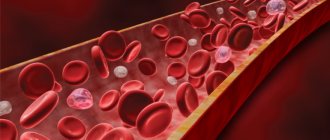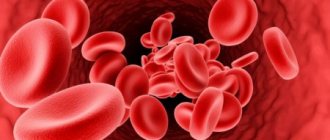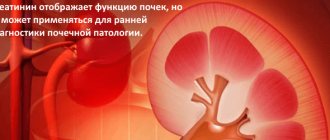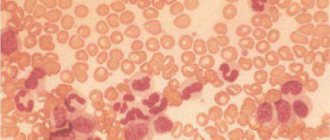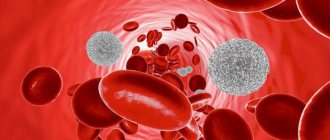Leukocytes in the blood of men
When diagnosing and suspecting the presence of diseases, the first thing that is prescribed to the patient is a general blood test. Based on the information received, one can judge the presence or absence of a pathological process.
In laboratories, blood is assessed according to several parameters, including the doctor assessing the content of blood cells, one of which is leukocytes. These white blood cells are cells of the immune system. They perform a protective function and are aimed at maintaining the internal environment of the body, destroying pathogenic bacteria and microbes.
An increased or decreased level of leukocytes in the blood indicates the presence of a pathological process and requires further diagnosis. What is the norm of leukocytes in the blood of men and how is such an analysis performed?
Types and functions of leukocytes
Leukocytes are a group of blood cells that do not have a nucleus or any color. They consist of blood cells that differ in structure:
- neutrophils (about 55%);
- lymphocytes (about 35%);
- monocytes (about 5%);
- eosinophils (about 2.5%);
- basophils (about 0.5%).
Their main task is to protect the body from pathogenic cells and microbes. If the body encounters a virus or infection, white blood cells attack foreign substances and destroy them. In this case, most of them also die. This is why the immune system constantly produces new white blood cells to replace the old ones.
In the body, leukocytes perform the following functions:
- identification and destruction of harmful bacteria and microorganisms (fungi, bacteria, viruses, infections);
- formation of immunity;
- destruction of microorganisms that cause an allergic reaction.
Leukocytes actively move and move between cells. It is there that they find foreign particles and destroy them, preventing the spread of viruses and infections.
Normal values
The level of leukocytes in the blood serum is constantly changing and depends on age.
What level of leukocytes a patient will have also depends on the person’s lifestyle, profession and level of physical activity.
After 60 years, minor deviations from the norm are allowed, and this is not always a sign of pathology. However, a pronounced deviation from the norm may indicate the development of a serious disease.
In tables and forms, the content of leukocytes is indicated by the abbreviation WBC (white blood cells), which literally translates as white blood cells. Below are the generally accepted norms of WBC in the blood of men depending on age:
| Age | leukocytes per 1 liter of blood |
| 0–12 months | 6–18 x 109 |
| 1–3 years | 5–13 x 109 |
| 4–15 years | 4–12 x 109 |
| 15–25 years | 4–9 x 109 |
| 26–40 years old | 4–7 x 109 |
| Over 40 years old | 3–7 x 109 |
After the age of 15, the number of white blood cells begins to slowly decline and returns to normal around age 20–21. After this age, the content of leukocytes in the blood of an adult man remains virtually unchanged.
Reasons for deviation from the norm
If a blood test shows that the white blood cell count is very abnormal, this indicates the presence of an internal pathological process. To identify what provoked such a reaction, it is necessary to undergo additional tests and diagnostics. It should be borne in mind that an increase and decrease in the number of white blood cells is associated with completely different reasons.
Reasons for the increase
In most cases, an increase in WBC in a blood test is associated with the action of various physiological factors, for example, recent food consumption, emotional or physical stress, as well as temperature conditions. For example, the concentration of leukocytes in the blood may increase if a person is exposed to heat or high humidity for a long time.
As for pathological causes, the following factors can provoke an increase in the level of leukocytes:
The norm of basophils in the blood
- the presence of an infectious-inflammatory disease;
- pneumonia of bacterial origin;
- pyelonephritis – a kidney disease accompanied by inflammation;
- dermatological diseases. Most often, an increase in leukocytes is observed with fungal infections of the skin and mucous tissues;
- inflammation of the tonsils caused by streptococci or staphylococci;
- appendicitis;
- formation of tumors of a malignant nature;
- recent heart attack or cerebral hemorrhage. Both of these pathologies are accompanied by the death of a significant amount of tissue;
- leukemia;
- heavy bleeding;
- thermal or chemical burn of a large area of skin;
- poisoning with chemicals, alcohol, drugs;
- intoxication of the body;
- diseases of the circulatory system or red brain.
If the white blood cell count deviates greatly from the norm, the patient is diagnosed with leukocytosis. It is worth understanding that an increase in the production of leukocytes can be associated with a variety of reasons, since the immune system is the first to respond to the slightest changes in the internal environment of the body.
Reasons for the decline
A deficiency of blood cells in the blood serum is called leukopenia. This condition may be caused by the following reasons:
- viral infectious diseases;
- hypersplenism is a pathology, the main characteristic of which is increased activity of the spleen;
- hypothyroidism is a disease accompanied by dysfunction of the thyroid gland;
- specific bacterial infections, for example, typhoid or typhus;
- pathologies of the endocrine system;
- parasitic diseases;
- rheumatoid arthritis, rheumatism and other diseases characterized by impaired activity of the immune system;
- anemia;
- long-term use of certain medications;
- intoxication with various substances that suppress the activity of red bone marrow;
- radiation sickness;
- body weight deficiency.
Pathologies leading to a decrease in the production of white blood cells, which are usually accompanied by a decrease and suppression of the immune system and the addition of a secondary bacterial infection.
If you suspect an increase or decrease in the level of leukocytes, you should immediately consult a doctor. After collecting anamnesis and physiological examination of the patient, the physician will issue a referral for a complete blood count, which will show the total concentration of leukocytes relative to leukocyte components.
If necessary, the doctor may prescribe additional tests that will help identify the overall clinical picture.
To avoid distortions and get a reliable result, you need to properly prepare for the analysis. 7 days before donating the biomaterial, it is recommended to stop taking any medications.
If a man is prescribed medication on an ongoing basis, he must notify the doctor about this.
3-5 days before the test, you need to reduce physical activity and stop going to the gym, you need to avoid stressful situations and emotional experiences. Before submitting the biomaterial, it is forbidden to eat or drink, so the analysis is usually carried out in the morning. Before the procedure, a man should not eat breakfast. The only thing allowed is to drink a glass of water.
It is important to consider that the last meal is taken no later than 8 hours before the examination; it is recommended to refrain from smoking 5 hours before the procedure. White blood cells are counted during a clinical blood test. To do this, the laboratory technician takes a small amount of blood from the finger.
The patient is then sent home and further examinations are carried out. To determine the number of leukocytes, blood is mixed with a special solution, which makes them more visible and allows you to calculate the approximate number.
Cell counting is usually carried out under a microscope in a Goryaev chamber
Decoding the result
Regardless of where the analysis was carried out - in a private clinic or in a municipal hospital, a form with the results is issued no later than 3 days later.
Only a qualified specialist should decipher the result.
It is worth considering the following: in order to identify the overall clinical picture, the physician evaluates not only the concentration of leukocytes, but also the percentage of leukocyte components.
Normally, their content should be as follows:
- segmented neutrophils – 55–65%;
- lymphocytes – 25–35%;
- monocytes – 3–8%;
- eosinophils – 2–4%;
- band neutrophils – 1–5%;
- basophils – less than 1%;
- young neutrophils – less than 1%.
Additional tests for deviations
If a blood test shows that the level of leukocytes and other blood components deviates greatly from acceptable values, the doctor will prescribe the patient additional tests and examinations that will help identify what caused this condition. The following studies are most often prescribed:
- determination of ESR (erythrocyte sedimentation rate);
- study of the cellular composition of the red brain by puncture sampling;
- determination of the activity of various antibodies;
- X-ray, computed tomography, magnetic resonance imaging.
Conclusion
A blood test for leukocytes is an accurate and effective procedure that shows a reliable result.
If a person strictly followed the preparation rules, but the analysis showed a deviation in the level of white blood cells from the norm, this is not yet a cause for concern, since their concentration can be increased due to intense physical activity or dietary habits. But in any case, only a qualified physician should draw conclusions about the patient’s physical condition.
Source: https://apkhleb.ru/krov/leykocity-muzhchin
Diagnostics
The primary diagnosis should be a blood test. When deviations from the norm are detected in the liquid connective tissue, the person is prescribed a full examination:
- ECG;
- Ultrasound of organs (especially the spleen);
- taking a puncture from the bone marrow;
- intestinal colonoscopy;
- smears of the oral cavity, genital organs;
- Analysis of urine. Kala;
- communication with a doctor.
Doctors can prescribe a detailed blood test, which will reflect the balance between the types of leukocytes discussed above. They will more accurately indicate the existing disease.
Attention!
People need to take care of their health. Frequent colds should be very suspicious. They “speak” of weak immunity, which indicates an increase in leukocytes in the hematopoietic system.
Norm of leukocytes in the blood of men by age (table)
The number of leukocytes is one of the main indicators in a general blood test. To correctly interpret the result of the study, you need to know what leukocytes are, what they are responsible for, what the norm corresponds to, and what a deviation from this value means.
Compliance of the concentration of leukocytes in the blood with the norm is an important criterion in the diagnosis of infectious and inflammatory processes, cancer and immune disorders.
The main types of mature leukocytes:
First of all, it is logical to mention that there are five main types of mature leukocytes in the blood. They are determined in tests in the form of a leukocyte formula, so the level of leukocytes in the blood is assessed not only as a whole. The content of these cells is also always calculated. These include (in descending order of quantity):
• Neutrophils
• Lymphocytes
• Monocytes
• Eosinophils
• Basophils.
They have different functions, but they work in collaboration, influence each other, transmit information among themselves, etc. High or low white blood cells in the blood, belonging to one type or another, indicate various diseases, so determining their number is very important in medical practice.
Decoding the results
On the test results form, leukocytes are indicated as WBC (white blood cells). In most cases, the same form indicates the age or general (adult) norm of leukocyte content.
In the absence of additional studies, an increase and decrease in the number of leukocytes in the blood does not mean that the patient necessarily has a pathology. If abnormalities are detected, the anamnesis is clarified, the patient is sent for re-examination and differential diagnosis, which identifies the causes of leukopenia (decreased cell concentration) and leukocytosis.
Depending on the reason for the referral for analysis, the blood test is interpreted by a therapist, an infectious disease specialist or a hematologist.
Increased level
The following types of leukocytosis are physiological:
- orthostatic (caused by rapid changes in body position);
- myogenic (provoked by muscle tension during hard work and sports activities);
- stressogenic (emotionogenic) and painful;
- nutritional (caused by a large meal, especially protein);
- physiotherapy (observed after physiotherapy procedures);
- hormonal (during menstruation, pregnancy, lactation).
This type of leukocytosis is not considered dangerous, although during heavy muscle activity the level of white cells may increase 3-5 times. In most cases, the physiological increase in the content of immune cells is not due to an increase in their production, but to the release of deposited leukocytes into the blood.
Pathological leukocytosis is observed in the following diseases:
- acute and chronic inflammatory diseases, incl. purulent processes (appendicitis, peritonitis);
- initial stage of sepsis;
- monocytic tonsillitis, infectious lymphocytosis;
- autoimmune inflammatory processes (SLE, rheumatoid arthritis);
- allergic reaction;
- diabetic coma;
- cerebral hemorrhage, infarction of internal organs, incl. myocardial infarction;
- acute circulatory failure (ACF), which developed against the background of large blood loss, severe burns and other injuries;
- chronic leukemia and other oncological diseases of the hematopoietic organs (in leukemic and subleukemic forms);
- renal failure accompanied by uremia;
- nonspecific ulcerative colitis;
- removal of the main depot of leukocytes (spleen) in history - splenectomy;
- intoxication (including drugs, alcohol, etc.);
- hypoxia;
- taking medications based on steroid hormones, administering adrenaline, etc.
In infectious and inflammatory processes, leukocytosis is a normal condition, and its absence indicates a weak immune response, impaired production of leukocytes (leukopoiesis) or a specific type of infection.
Reduced level
The reasons for a decrease in the number of leukocytes may be the following:
- hypoplasia or complete absence of hematopoietic tissue (bone marrow);
- accumulation of blood cells in the enlarged spleen tissue (hypersplenism);
- acute leukemia, myeloma, other proliferative diseases of the lymphoid and myeloid branches of hematopoiesis;
- myelodysplastic syndrome, metastases of malignant neoplasia to the bone marrow;
- radiation sickness;
- myelofibrosis;
- anemia due to vitamin B12 deficiency;
- typhoid fever, malaria, paratyphoid fever, measles, rubella, influenza and acute hepatitis;
- carriage and exacerbation of herpes viruses serotypes 6 and 7;
- collagenosis;
- anaphylactic shock;
- sepsis;
- damage to hematopoietic cells by toxins (benzene, aniline, cytostatic drugs);
- drug therapy (taking NSAIDs, cytostatics, antibiotics, sulfonamides, thyreostatic and antispasmodic drugs, anticonvulsants).
A deficiency of leukocytes may be caused by insufficient consumption of substances that are involved in hematopoiesis, or the active use of substances that block the normal absorption of these components.
Micro- and macroelements that are important for leukopoiesis include B vitamins (in particular, thiamine, folic acid and cyanocobalamin - vitamins B1, B9 and B12), vitamin C, iron and copper.
Source: https://MedLazaret.ru/kardio/lejkocity-norma-u-muzhchin.html
Leukocytosis
Leukocytosis is a pathology characterized by a sharp change in blood composition. Leukocytes can change smaller or larger, they grow. Due to the appearance of aggressive agents. They become active and multiply, trying to protect themselves from attacks. Leukocytosis is not a disease, but a condition that requires extensive diagnosis. Pathologies of various etiologies may be hidden under it. Treatment can be prescribed only after a complete examination and diagnosis.
Kinds:
Basophilic - due to an increase in the production of basophils (the smallest category of white cells), fights allergic, toxic manifestations, is rarely observed in gastrointestinal diseases.
Neutrophilic - plays an important role in the fight against various infectious and bacterial diseases.
Eosinophilic - takes part in processes caused by an allergic reaction. Eosinophils are able to resist parasitic infections and helminthic infestations.
White blood cells normal in men by age table
Like a woman » Beauty and health » House doctor » Tests
Leukocytes mean a heterogeneous group of blood cells that differ in appearance and role. They are united by the presence of a nucleus and the absence of independent coloring.
They are important components of the blood, because the main sphere of action of leukocytes is to protect the body from pathogenic agents, internal and external.
They protect the human body from illnesses and help cope with them if the disease does penetrate inside.
Types of leukocytes and their functions
Leukocytes consist of:
- neutrophils (55%);
- lymphocytes (35%);
- monocytes (5%);
- eosinophils (2.5%);
- basophils (0.5%).
In more detail, the functions of leukocytes are as follows:
- destruction of bacterial infection in the blood;
- responsibility for general immunity and the presence of immune memory;
- absorption of foreign agents entering the blood;
- fight against particles that provoke allergies;
- act as scout cells that help detect foreign particles.
Absolutely all leukocytes move briskly and easily seep into the space between the cells. It is there that they find and absorb foreign particles, thereby protecting the body from infections and viruses. They die en masse, which is why it is so important that the body is able to produce new ones in sufficient quantities to replace the lost leukocytes.
Leukocytes in men: normal
In male blood in young years, the concentration of leukocytes depends on age. The norms of white blood cells are as follows:
| Quantity | |
| years | leukocytes (?109) |
| Up to 15 | 4,3–9,5 |
| 15–20 | 4,1–9,3 |
| Over 21 | 4,0–9,0 |
Starting from adolescence, the number of leukocytes in the male body gradually decreases. After twenty-one years, the norm no longer changes. It is the same for representatives of both sexes and is in the following range: 4.0–9.0×109 per liter of blood.
According to some data, in men of advanced age (after seventy years) a further decrease in leukocytes is possible. The norm during this period is in the range from 3.8 to 8.7?109.
When you have a cold, the number of white blood cells rises to the upper limit and is 8.5 or 9 units. Fighting the infection, a huge number of leukocytes die. And when the body is almost healthy, the level of white cells drops to the lower limit of normal. The body's protective functions are significantly weakened, and leukocytes need time to recover.
Leukocytes: influencing factors
In order to control the level of leukocytes, you need to periodically resort to laboratory tests and donate blood for analysis. It is he who determines how effectively the processes of protection and restoration occur in the body.
The average white blood cell count in an adult male ranges from 4.2 to 8.9×109 per liter. However, the specific value depends on some subjective and physiological factors, namely:
- the body is rested or tired after a day of work or physical activity;
- what time of day: afternoon, evening or morning. More accurate analysis results are noted earlier in the day;
- whether a person is full or hungry. The presence or absence of food in the stomach affects the number of leukocytes;
- psychological state: enduring positive and negative stress, emotional outbursts and overloads. Or the man is calm and balanced.
The number of leukocytes can also be affected by:
- exposure to the sun;
- visit to the bathhouse and steam room;
- the presence of unhealthy habits - smoking and addiction to alcoholic beverages;
- uncontrolled use of certain medications.
Therefore, it is recommended to donate blood for analysis in the morning on an empty stomach. The body needs to be adjusted so that it is in a state of rest and relaxation.
Deviations from the norm: reasons
Depending on the content of leukocytes in a man’s blood, the following deviations from the established norm are recorded:
- Exceeding the level of white blood cells is leukocytosis.
- The level of leukocytes is below normal - leukopenia.
In addition, irregularities in the leukocyte formula, which contains information about the types of leukocytes, can be recorded. Their percentage ratio is relatively constant and shows the state of the immune system.
The deviation of leukocytes from the established norm itself is not a disease. This is only a consequence of undesirable processes occurring in the male body.
White blood cells are elevated
The following causes of leukocytosis can be distinguished:
- The presence of inflammatory processes in the pelvic organs, namely in: the rectum;
- bladder;
- prostate gland;
- seminal vesicles.
The increase in the number of white blood cells can also be affected by:
- great physical overload;
- poor nutrition;
- absence of the spleen, removed for medical reasons.
Additional tests will help identify which leukocytes are responsible for their excess increase. Depending on this, leukocytosis occurs:
- Eosinophilic - manifests itself along with allergic reactions.
- Basophilic – accompanies gastrointestinal diseases, in particular colitis and gastritis.
- Lymphocytic – acute and chronic infections such as hepatitis and tuberculosis have settled in the body.
- Monocytic - the culprits of leukocytosis are bacterial infections, and sometimes cancer.
White blood cells below normal
A decrease in leukocytes below the established norm is doubly dangerous. Firstly, the body suffers from a disease that causes a decrease in white blood cells. Secondly, resistance decreases, and the threat of contracting an additional disease increases.
Leukopenia is caused by the following reasons:
- excessive use of hormones, analgesics, anti-inflammatory drugs;
- acute viral disease;
- weakened immunity;
- certain forms of leukemia;
- disruptions in the functioning of the endocrine system.
The level of leukocytes in the male body can change in one direction or another throughout the day. This is influenced by diet, cigarette and alcohol abuse, and psychological state.
A decrease or increase in the level of leukocytes in the blood of men indicates that the immune system is weakened and pathogenic processes are occurring in the body. Therefore, it does not hurt to conduct an additional examination and identify the cause of such phenomena.
Source:
The norm of leukocytes in the blood of men: tables by age, reasons for deviation
Leukocytes are white blood cells that are the basis of the immune system.
They move freely throughout the body, contain a special enzyme that breaks down and binds breakdown products, and gets rid of foreign agents.
You can read about the norm of leukocytes in women here.
Functions of leukocytes
The key functions of leukocytes are:
- Absorption of foreign substances;
- Destroying infection;
- Fight against substances that provoke an allergic reaction;
- Responsible for local immunity;
- Synthesize antibodies;
- They develop memory for foreign agents and pass them on to the next generation;
- Act as “scouts”, helping to recognize foreign particles;
- Remove breakdown products from the body.
Normal blood levels depending on age
In men, the normal number of leukocytes in the blood ranges from 4–9 × 10 to the 9th power, table by age:
| Age | Leukocytes (×109) |
| Up to 15 | 4,3–9,5 |
| 15–20 | 4,1–9,3 |
| Over 21 | 4,0–9,0 |
After the age of 55, especially in the elderly, after 70, the norm of leukocytes in the blood of men decreases to 3.8–8.7 × 10 to the 9th power. This is due to the fact that the viability of leukocytes decreases, as functional and structural changes occur in them.
The bone marrow, which synthesizes leukocytes, also undergoes changes, adipose tissue grows in it, and the production of nucleated cells decreases.
Now you know what the norm of leukocytes in the blood of men is, but what could be the reasons for the deviation?
The level of leukocytes in the blood of men may vary depending on the following situations:
- Physical, emotional stress;
- Staying in the sun, tanning;
- Hungry or full stomach (after eating, the number of white blood cells increases);
- Visiting a bathhouse, steam room;
- Fatigue;
- Stressful situation;
- Uncontrolled use of certain medications (antibiotics, anti-inflammatory drugs);
- Blood transfusion (donation);
- Smoking, drinking alcohol;
- Poor nutrition (leads to an increase in the level of leukocytes);
- Time of day (leukocyte levels increase in the evening).
Changes in the level of leukocytes can be of the following types:
- Primary changes - observed in diseases of the hematopoietic system;
- Secondary - occur depending on the reaction of the circulatory system to various pathological conditions that occur in other systems and organs.
Deviations from the norm
Deviations from normal indicators can be of the following types:
- Leukocytosis - an increase in the level of white cells in the blood against the background of inflammatory processes, in physiological (natural) conditions;
- Leukopenia – a decrease in the number of leukocytes is observed with reduced immunity, purulent-inflammatory processes, bone marrow diseases;
- Disturbances in the composition of the leukocyte formula;
- Extra immature white blood cells.
Leukocytosis
The main reasons for the increase in the number of white blood cells are:
Leukocytosis is divided into the following classes:
- Basophilic – observed in diseases of the gastrointestinal tract;
- Monocytic – occurs against the background of a bacterial infection and in the presence of cancerous tumors;
- Eosinophilic – observed in allergic reactions;
- Lymphocytic - occurs in the presence of acute and chronic infections.
The reasons for deviation of the level of leukocytes from the norm can be serious, or can only mean a weakened immune system.
Source: https://krovinushka.ru/analizi/lejkotsity-norma-u-muzhchin-po-vozrastu-tablitsa.html
How to find out your leukocyte level - indications and preparation for analysis
The analysis is performed on an empty stomach early in the morning. It allows you to determine what kind of hemoglobin a man has, the number of red blood cells, the color indicator of the corpuscles, how many reticulocytes are in the blood, the number of platelets, what is the leukocyte formula in a man’s blood.
You can’t even drink tea on an empty stomach, because... it may distort all results or give an incorrect clinical picture. Tests are taken in a special clinical laboratory, after which cells and blood cells are counted under a microscope. In young men under 30 years of age, in mature men (up to 60 years of age) and persons older than this age, the indicators differ.
The norm of leukocytes in the blood of men: tables by age, reasons for deviation
Leukocytes are white blood cells that are the basis of the immune system.
They move freely throughout the body, contain a special enzyme that breaks down and binds breakdown products, and gets rid of foreign agents.
You can read about the norm of leukocytes in women here.
Leukopenia
A decrease in the level of leukocytes in the blood in men can be observed under the following conditions:
Rules for donating blood
Before taking a clinical blood test, you must follow the following recommendations to ensure that the test results are reliable:
- 2 days before the test, you should exclude salty and fatty foods from your diet, and completely stop drinking alcohol;
- The day before the test, avoid emotional and physical stress;
- Blood is drawn on an empty stomach no later than 12 noon;
- On the day of the test, you need to stop taking medications;
- Stop smoking 60 minutes before the test;
- 10-15 minutes before taking the test, you need to sit in a calm environment.
Symptoms of leukocytosis
This is not an independent disease, it is caused by third-party influence. Each disease has its own symptoms. There are also general signs that indicate a decrease in the level of discolored blood particles:
- fatigue, weakness, lethargy;
- dizziness, fainting;
- loss of appetite, weight, nausea, vomiting;
- shortness of breath, intermittent breathing;
- weakened vision.
During this period, the body weakens, it is vulnerable and susceptible to infectious diseases. May be observed:
Temperature increase;
- chills, fever;
- heartbeat and pulse increase;
- ulcers appear in the mouth and on the intestinal walls;
- compaction of lymphatic tissue;
- tonsils enlarge.
Leukopenia
With leukopenia, the number of white blood cells in the body decreases. The causes of leukopenia can be hypoplasia and aplasia of the brain. This disease can occur if the bone marrow is damaged after taking various medications. X-ray irradiation, deficiency of substances (such as folic acid, iron, copper), metastases in oncology, typhus - all this causes leukopenia.
The following symptoms occur with leukopenia:
- weakening of the body;
- temperature increase;
- the person is shivering;
- heart rate decreases;
- there is constant anxiety;
- headaches appear.
